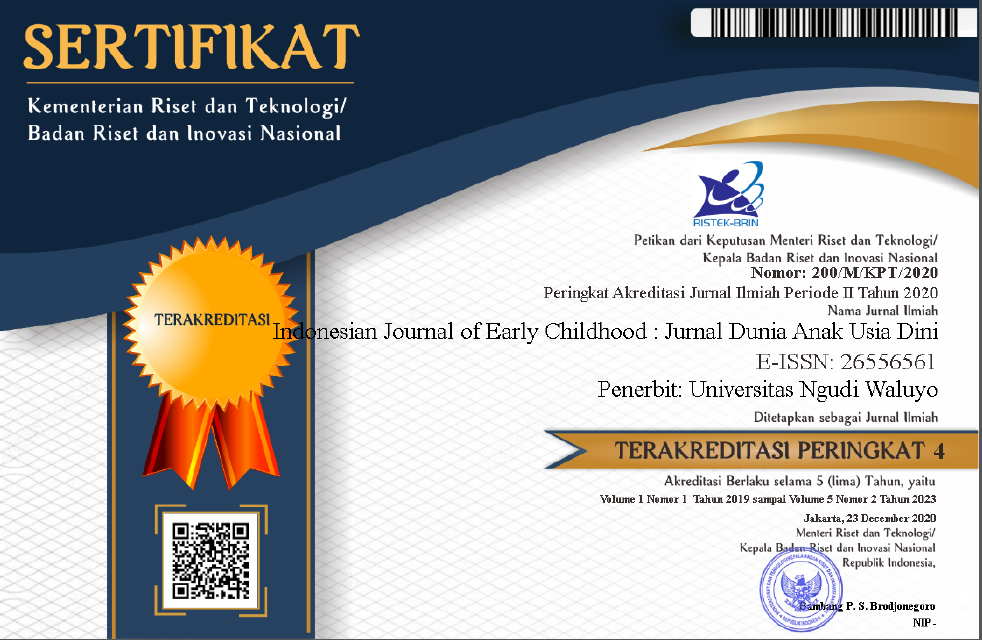Pemanfaatan AI Speech To Text untuk Menstimulasi Kemampuan Berbicara Anak Usia Dini
Utilization of AI Speech To Text to Stimulate Early Childhood Speaking Skills
DOI:
https://doi.org/10.35473/ijec.v7i1.3614Keywords:
anak usia dini, kemampuan berbicara, speech to text, teknologiAbstract
Speaking is a vital basic skill for early childhood, as it is the foundation for future communication and language development. In the digital era, technologies such as speech-to-text offer new opportunities to create interactive and visual-based learning experiences, thus supporting children in developing their speaking skills more effectively. This study aims to explore the use of speech-to-text technology in supporting children's speaking skills at Nurul Huda Palaran Kindergarten. The approach applied is descriptive qualitative, with sources designed through observation, interviews, and documentation to provide an in-depth understanding of the application of this technology in the learning process. The data analysis process follows three main stages adapted from Miles and Huberman, namely data reduction, data presentation, and drawing conclusions. The study shows that the application of speech-to-text technology has a positive impact on improving children's pronunciation, fluency, and vocabulary mastery. This technology provides direct feedback to children in the form of text from speech, which helps children recognize errors and correct them. However, several challenges were found, such as inaccurate transcription for certain pronunciations, which were successfully overcome through teacher assistance to provide further guidance. In conclusion, the integration of speech-to-text technology is an effective innovative approach to support the development of early childhood speaking skills. The success of implementing this technology is highly dependent on the combination of optimal use of technology and a humanistic approach by teachers to create a balanced learning experience.
ABSTRAK
Berbicara adalah sebuah keterampilan dasar yang vital bagi anak usia dini, karena menjadi pondasi bagi perkembangan komunikasi dan bahasa dimasa depan. Dalam era digital, teknologi seperti speech-to-text menawarkan kesempatan baru untuk memunculkan pengalaman belajar yang interaktif dan berbasis visual, sehingga mendukung anak dalam mengembangkan kemampuan berbicara secara lebih efektif. Penelitian ini bertujuan untuk mengeksplorasi penggunaan teknologi speech-to-text dalam menunjang kecakapan berbicara anak di TK Nurul Huda Palaran. Pendekatan yang diterapkan adalah kualitatif deskriptif, dengan sumber yang dirancang melalui observasi, wawancara, dan dokumentasi untuk memberikan pemahaman mendalam tentang penerapan teknologi ini dalam proses pembelajaran. Proses analisis data mengikuti tiga tahap utama yang diadaptasi dari Miles dan Huberman, yaitu reduksi data, penyajian data, dan penarikan kesimpulan. Telaah menunjukkan bahwa penerapan teknologi speech-to-text memiliki dampak positif dalam meningkatkan aspek pelafalan, kelancaran berbicara, dan penguasaan kosakata anak. Teknologi ini memberikan umpan balik langsung kepada anak dalam bentuk teks dari ucapan, yang membantu anak mengenali kesalahan dan memperbaikinya. Meski demikian, ditemukan beberapa tantangan, seperti ketidakakuratan transkripsi untuk pelafalan tertentu, yang berhasil diatasi melalui pendampingan guru untuk memberikan bimbingan lebih lanjut. Kesimpulannya, integrasi teknologi speech-to-text merupakan pendekatan inovatif yang efektif untuk mendukung pengembangan kemampuan berbicara anak usia dini. Keberhasilan penerapan teknologi ini sangat bergantung pada kombinasi antara pemanfaatan teknologi secara optimal dan pendekatan humanistik oleh guru untuk menciptakan pengalaman belajar yang seimbang.
References
Alamin, Z., Missouri, R., & Lukman, L. (2022). Pemanfaatan Teknologi Informasi dalam Pengembangan Materi Pendidikan Agama Islam: Tinjauan Aplikasi Interaktif Al-Qur’an Digital. TAJDID: Jurnal Pemikiran Keislaman Dan Kemanusiaan, 6(2), 296–306. https://doi.org/10.52266/tadjid.v6i2.1202
Anggraini, R., Lumbangaol, R. R., Pakpahan, R. B., Berbicara, K., & Inggris, B. (2024). Penggunaan Aplikasi Elsa Speak Dalam Belajar Speaking Bahasa Inggris Di Smk Swasta Pelita. Communnity Development Journal, 5(4), 7241–7245.
B, I., Thamrin, A. N., & Milani, A. (2024). Implementasi Etika Penggunaan Kecerdasan Buatan (AI) dalam Sistem Pendidikan dan Analisis Pembelajaran di Indonesia. Digital Transformation Technology, 4(1), 714–723.
Creswell, J. W. (2014). Research Design: Qualitative, Quantitative and Mixed Methods Approaches (Fourth Edi). SAGE Publications, Inc.
Devanti, D., Muftiana, W., Fai, U., Kutai, K., Tenggarong, K., & Timur, I. (2023). Tranformasi Guru Profesional Penerapan Pendekatan Student Centered Learning (Scl). AZKIYA: Jurnal Ilmiah Pengkajian Dan Penelitian Pendidikan Islam, 6(2), 15–29.
Elan, E., Sumardi, S., & Juandi, A. S. (2022). Penyusunan Instrumen Penelitian Tindakan Kelas dalam Upaya Peningkatakan Keterampilan Sosial. Jurnal Paud Agapedia, 6(1), 91–98. https://doi.org/10.17509/jpa.v6i1.51339
Ernawati, S., Wati, R., & Maulana, I. (2023). Aplikasi Android Pengenalan Hewan Multi Bahasa Untuk Meningkatkan Kognitif Anak. Jurnal Informatika & Rekayasa Elektronika, 6(2), 255–253.
Gusti Feriyanti, Y. (2024). Tinjauan Pemanfaatan Kecerdasan Buatan: Pembelajaran Mandiri Pada Keterampilan Bahasa Indonesia. LITERASI: Jurnal Ilmiah Pendidikan Bahasa, Sastra Indonesia Dan Daerah, 14(2), 675–682. https://doi.org/10.23969/literasi.v14i2.13138
Hakiki, R., Norhan, L., & Dewi, W. N. (2024). Pengembangan Teknologi Berbasis AI: Tantangan dan Peluang. Takaza Innovatix.
Hasanah, L., Dewi, R. K., Maulida, A., Fanbilah, I. F., & Wardani, T. P. (2024). Model Kurikulum dengan Pendekatan Sentra pada Lembaga Pendidikan Anak Usia Dini. Jurnal Paud Agapedia, 8(1), 83–96. https://doi.org/10.17509/jpa.v8i1.71765
Hidayat, T., & Mulyoto, A. (2022). Perancangan Aplikasi Pembelajaran Siswa Berbasis Web Menggunakan Speech To Text Pada Sdn 2 Pabuaran. OKTAL : Jurnal Ilmu Komputer Dan Science, 1(10), 1579–1585.
Jenita, Harefa, A. T., Hanafiah, H., & Rukiyanto, B. A. (2023). Pemanfaatan Teknologi Dalam Menunjang Pembelajaran: Pelatihan Interaktif Dalam Meningkatkan Kualitas Pendidikan. Community …, 4(6), 13121–13129.
Juniarti, F. (2018). Meningkatkan Percaya Diri Anak Pada Aspek Kognitif Dengan Metode Bercerita. Jurnal Tunas Siliwangi, 4(1), 23–37.
Khosibah, S. A., & Dimyati, D. (2021). Bahasa Reseptif Anak Usia 3-6 Tahun di Indonesia. Jurnal Obsesi : Jurnal Pendidikan Anak Usia Dini, 5(2), 1860–1869. https://doi.org/10.31004/obsesi.v5i2.1015
Miles M.B., Huberman, A.M., S. J. (2014). Qualitative Data Analysis: A Methods Sourcebook (Third). SAGE Publications, Inc.
Nizrina, E. H., Rusdiyani, I., & Fadlullah, F. (2022). Efektivitas Multimedia Interaktif Dalam Meningkatkan Kemampuan Bahasa Anak Usia 4-5 Tahun. As-Sibyan: Jurnal Pendidikan Anak Usia Dini, 7(2), 205–220. https://doi.org/10.32678/assibyan.v7i2.9828
Noviyanti, A. I., Hidayanto, N. E., & Wijaya, P. R. (2023). Pembelajaran Berbasis AI (Artificial Intelligence) untuk Anak Usia Dini. JECIE (Journal of Early Childhood and Inclusive Education), 7(1), 150–155. https://doi.org/10.31537/jecie.v7i1.1514
Rahayu, M., Rusdiyani, I., & Fadlullah, F. (2022). Efektivitas Multimedia Pembelajaran Interaktif Dalam Menstimulasi Kemampuan Berbicara Anak Usia 5-6 Tahun. Tunas Siliwangi : Jurnal Program Studi Pendidikan Guru PAUD STKIP Siliwangi Bandung, 8(2), 108. https://doi.org/10.22460/ts.v8i2p108-114.3175
Ramadhan, M. F., Yogyakarta, U. T., Sleman, K., & Yogyakarta, D. I. (2024). Inclusive Android-Based Solution : E-Book Reader Application With Text-To-Speech For Empowering People With Disabilities Solusi Inklusif Berbasis Android : Aplikasi E- Book Reader Dengan Text-To-Speech Untuk. Jurnal Inovtek Polbeng-Seri Informatika, 9(2), 643–655.
Rizal, R. S., Tamam, A. M., & Rahman, I. K. (2023). Pendekatan Belajar Berpusat Pada Guru Dalam Perspektif Ulama Klasik Dan Kontemporer. Jurnal Hikmah, 12(2), 165–173.
S, D. A., & Aziz, T. (2024). Pendekatan Hybrid Self Training Dalam Pengembangan Sosial-Emosional Anak Usia Dini. Early Childhood: Jurnal Pendidikan, 8(2), 1–17.
Saraswati, L., Sukartiningsih, W., & Subrata, H. (2024). Analisis Kebutuhan Awal Penggunaan Media Visual Berbasis AI dalam Keterampilan Berbicara. Journal of Education Research, 5(3), 3544–3556. https://doi.org/10.37985/jer.v5i3.1164
Sugiyono. (2017). Metode Penelitian Pendidikan (Pendekatan Kuantitatif, Kualitatif, dan R&D. Alfabeta.
Sulistyawati, R., & Amelia, Z. (2021). Meningkatkan Kemampuan Berbicara Anak Melalui Media Big Book. Jurnal Anak Usia Dini Holistik Integratif (AUDHI), 2(2), 67. https://doi.org/10.36722/jaudhi.v2i2.582
Suryana, E., Aprina, M. P., & Harto, K. (2022). Teori Konstruktivistik dan Implikasinya dalam Pembelajaran. JIIP - Jurnal Ilmiah Ilmu Pendidikan, 5(7), 2070–2080. https://doi.org/10.54371/jiip.v5i7.666
Wati, S. O., Zaim, M., & Thahar, H. E. (2023). Aplikasi Teori Konstruktivisme dalam Konteks Pengajaran Bahasa Asing. Journal of Education Research, 4(1), 2480–2485.
Zahwa, F. A., & Syafi’i, I. (2022). Pemilihan Pengembangan Media Pembelajaran Berbasis Teknologi Informasi. Equilibrium: Jurnal Penelitian Pendidikan Dan Ekonomi, 19(01), 61–78. https://doi.org/10.25134/equi.v19i01.3963
Downloads
Published
How to Cite
Issue
Section
License
Copyright (c) 2025 Indonesian Journal of Early Childhood: Jurnal Dunia Anak Usia Dini

This work is licensed under a Creative Commons Attribution-ShareAlike 4.0 International License.
Please find the rights and licenses in Indonesian Journal Of Early Childhood: Jurnal Dunia Anak Usia DIni. By submitting the article/manuscript of the article, the author(s) agree with this policy. No specific document sign-off is required.
1. License
The non-commercial use of the article will be governed by the Creative Commons Attribution license as currently displayed on Creative Commons Attribution-ShareAlike 4.0 International License.
2. Author(s)' Warranties
The author warrants that the article is original, written by stated author(s), has not been published before, contains no unlawful statements, does not infringe the rights of others, is subject to copyright that is vested exclusively in the author and free of any third party rights, and that any necessary written permissions to quote from other sources have been obtained by the author(s).
3. User Rights
Indonesian Journal Of Early Childhood: Jurnal Dunia Anak Usia Dini's spirit is to disseminate articles published are as free as possible. Under the Creative Commons license, Indonesian Journal Of Early Childhood: Jurnal Dunia Anak Usia Dini permits users to copy, distribute, display, and perform the work for non-commercial purposes only. Users will also need to attribute authors and Indonesian Journal Of Early Childhood: Jurnal Dunia Anak Usia Dini on distributing works in the journal and other media of publications.
4. Co-Authorship
If the article was jointly prepared by more than one author, any authors submitting the manuscript warrants that he/she has been authorized by all co-authors to be agreed on this copyright and license notice (agreement) on their behalf, and agrees to inform his/her co-authors of the terms of this policy. Indonesian Journal Of Early Childhood: Jurnal Dunia Anak Usia Dini will not be held liable for anything that may arise due to the author(s) internal dispute. Indonesian Journal Of Early Childhood: Jurnal Dunia Anak Usia Dini will only communicate with the corresponding author.
5. Miscellaneous
Indonesian Journal Of Early Childhood: Jurnal Dunia Anak Usia Dini will publish the article (or have it published) in the journal if the article’s editorial process is successfully completed. Indonesian Journal Of Early Childhood: Jurnal Dunia Anak Usia Dini's editors may modify the article to a style of punctuation, spelling, capitalization, referencing and usage that deems appropriate. The author acknowledges that the article may be published so that it will be publicly accessible and such access will be free of charge for the readers as mentioned in point 3.
Â
Every accepted manuscript should be accompanied by "Copyright Transfer Agreement" prior to the article publication.



